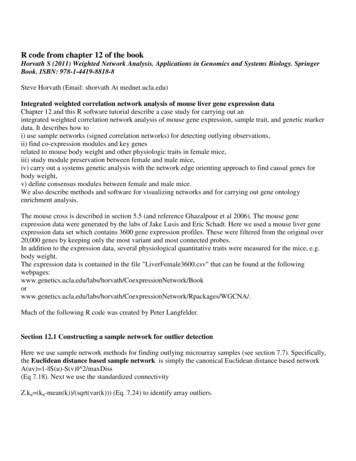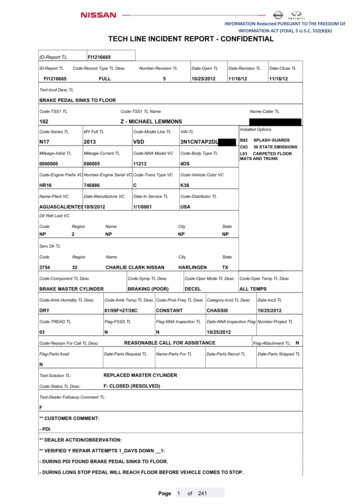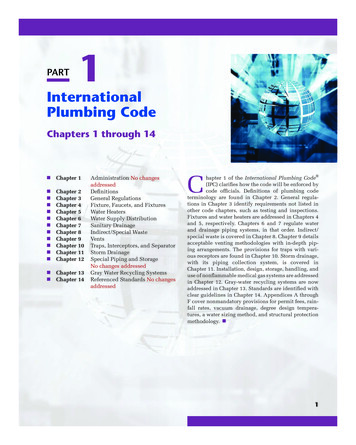
Transcription
R code from chapter 12 of the bookHorvath S (2011) Weighted Network Analysis. Applications in Genomics and Systems Biology. SpringerBook. ISBN: 978-1-4419-8818-8Steve Horvath (Email: shorvath At mednet.ucla.edu)Integrated weighted correlation network analysis of mouse liver gene expression dataChapter 12 and this R software tutorial describe a case study for carrying out anintegrated weighted correlation network analysis of mouse gene expression, sample trait, and genetic markerdata. It describes how toi) use sample networks (signed correlation networks) for detecting outlying observations,ii) find co-expression modules and key genesrelated to mouse body weight and other physiologic traits in female mice,iii) study module preservation between female and male mice,iv) carry out a systems genetic analysis with the network edge orienting approach to find causal genes forbody weight,v) define consensus modules between female and male mice.We also describe methods and software for visualizing networks and for carrying out gene ontologyenrichment analysis.The mouse cross is described in section 5.5 (and reference Ghazalpour et al 2006). The mouse geneexpression data were generated by the labs of Jake Lusis and Eric Schadt. Here we used a mouse liver geneexpression data set which contains 3600 gene expression profiles. These were filtered from the original over20,000 genes by keeping only the most variant and most connected probes.In addition to the expression data, several physiological quantitative traits were measured for the mice, e.g.body weight.The expression data is contained in the file "LiverFemale3600.csv" that can be found at the .Much of the following R code was created by Peter Langfelder.Section 12.1 Constructing a sample network for outlier detectionHere we use sample network methods for finding outlying microarray samples (see section 7.7). Specifically,the Euclidean distance based sample network is simply the canonical Euclidean distance based networkA(uv) 1- S(u)-S(v) 2/maxDiss(Eq 7.18). Next we use the standardized connectivityZ.ku (ku-mean(k))/(sqrt(var(k))) (Eq. 7.24) to identify array outliers.
In the following, we present relevant R code.# Change the path to the directory# On Windows use a forward slash / instead of the usual \.setwd("C:/Documents and Settings/Steve r)options(stringsAsFactors FALSE)#Read in the female liver data setfemData read.csv("LiverFemale3600.csv")dim(femData)[1] 3600 143Note there are 3600 genes and 143 columnsThe column names arenames(femData)# the output shows that the first 8 columns contain gene information[1] "substanceBXH""gene symbol" "LocusLinkID"[5] "cytogeneticLoc" "CHROMOSOME" "StartPosition"[9] "F2 2""F2 3""F2 14"[13] "F2 19""F2 20""F2 23".ETC (remainder of output"ProteomeID""EndPosition""F2 15""F2 24"omitted)#Remove gene information and transpose the expression datadatExprFemale as.data.frame(t(femData[, -c(1:8)]))names(datExprFemale) femData substanceBXHrownames(datExprFemale) names(femData)[-c(1:8)]# Now we read in the physiological trait datatraitData traitData)# use only a subset of the columnsallTraits traitData[,c(2, 11:15, 17:30, 32:38)]names(allTraits)[1] "Mice"[4] "ab fat"[7] "X100xfat weight"[10] "HDL Chol"[13] "Glucose"[16] "Insulin ug l"[19] "Adiponectin"[22] "Aortic cal M"[25] "Myocardial cal""weight g""other fat""Trigly""UC""LDL plus VLDL""Glucose Insulin""Aortic.lesions""Aortic cal L""BMD all limbs"# Order the rows of allTraits so that# they match those of datExprFemale:Mice rownames(datExprFemale)traitRows match(Mice, allTraits Mice)"length cm""total fat""Total Chol""FFA""MCP 1 phys""Leptin pg ml""Aneurysm""CoronaryArtery Cal""BMD femurs only"
datTraits allTraits[traitRows, -1]rownames(datTraits) allTraits[traitRows, 1]# show that row names agreetable(rownames(datTraits) rownames(datExprFemale))TRUE135Message: the traits and expression data have been aligned correctly.# sample network based on squared Euclidean distance# note that we transpose the dataA adjacency(t(datExprFemale),type "distance")# this calculates the whole network connectivityk as.numeric(apply(A,2,sum))-1# standardized connectivityZ.k scale(k)# Designate samples as outlying# if their Z.k value is below the thresholdthresholdZ.k -5 # often -2.5# the color vector indicates outlyingness (red)outlierColor ifelse(Z.k thresholdZ.k,"red","black")# calculate the cluster tree using flahsClust or hclustsampleTree flashClust(as.dist(1-A), method "average")# Convert traits to a color representation:# where red indicates high valuestraitColors data.frame(numbers2colors(datTraits,signed FALSE))dimnames(traitColors)[[2]] paste(names(datTraits),"C",sep "")datColors data.frame(outlierC outlierColor,traitColors)# Plot the sample dendrogram and the colors els names(datColors),colors datColors,main "Sample dendrogram and trait heatmap")
Caption: Cluster tree of mouse liver samples. The leaves of the tree correspond to the mice. The first colorband underneath the tree indicates which arrays appear to be outlying. The second color band representsbody weight (red indicates high values). Similarly, the remaining color-bands color-code the numericvalues of physiologic traits.The Figure shows the resulting cluster tree where each leaf corresponds to a mouse sample. The first colorband underneath the tree indicates which samples appear outlying (colored in red) according to a low value.The mouse labelled F2 221 is highly outlying (Z.k -5), which is why we remove it from the subsequentanalysis.The other color bands color-code physiological traits. Note that the outlying samples do not appear to havesystematically differentphysiologic trait values. Although the outlying samples are suspicious, we will keep them in the subsequentanalysis.# Remove outlying samples from expression and trait dataremove.samples Z.k thresholdZ.k is.na(Z.k)datExprFemale datExprFemale[-remove.samples,]datTraits datTraits[-remove.samples,]# Recompute the sample network among the remaining samplesA adjacency(t(datExprFemale),type "distance")# Let's recompute the Z.k values of outlyingnessk as.numeric(apply(A,2,sum))-1Z.k scale(k)Section 12.2: Co-expression modules in female mouse livers12.2.1: Choosing the soft threshold beta via scale free topologyAs detailed in section 4.3, we propose to choose the soft threshold power betabased on the scale free topology criterion Zhang and Horvath 2005, i.e. we choose the lowest beta thatresults in approximate scale free topology as measured by the scale free topology fitting index (Eq. 1.13)R 2 ScaleFreeFit cor(log(p(dk)),log(BinNo)) 2
The following R code illustrates the use of the R function pickSoftThreshold for calculatingscale free topology fitting indices R 2 corresponding to different soft thresholding powers beta.# Choose a set of soft thresholding powerspowers c(1:10) # in practice this should include powers up to 20.# choose power based on SFT criterionsft pickSoftThreshold(datExprFemale,powerVector powers)#outputPower SFT.R.sq slope truncated.R.sq mean.k. median.k. max.k.110.0378 0.4010.503 747.00764.00 1210.0220.1610 -0.7070.860 255.00251.00 575.0330.3870 -1.1500.983 112.00102.00 324.0440.5430 -1.5500.97457.0047.80 202.0550.7020 -1.8100.93832.5025.30 134.0660.9110 -1.5700.95720.1014.5095.0770.9240 -1.7100.91513.408.8284.3880.9080 -1.7400.8829.375.5376.5990.8730 -1.7100.8566.883.6370.710100.8330 -1.6700.8345.262.4765.9#Digression: if you want to pick a soft threshold for a signed network write#sft pickSoftThreshold(datExprFemale,powerVector powers, networkType "signed")# but then you should consider higher powers. Default beta 12.# Plot the results:par(mfrow c(1,2))# SFT index as a function of different powersplot(sft fitIndices[,1],-sign(sft fitIndices[,3])*sft fitIndices[,2],xlab "Soft Threshold (power)",ylab "Scale Free Topology Model Fit,signed R 2",type "n",main paste("Scale independence"))text(sft fitIndices[,1],-sign(sft fitIndices[,3])*sft fitIndices[,2],labels powers,col "red")# this line corresponds to using an R 2 cut-off of habline(h 0.90,col "red")# Mean connectivity as a function of different powersplot(sft fitIndices[,1],sft fitIndices[,5],type "n",xlab "Soft Threshold (power)",ylab "Mean Connectivity",main paste("Mean connectivity"))text(sft fitIndices[,1],sft fitIndices[,5],labels powers,col "red")
Scale independence78110Mean Connectivity0.60.4422003400600950.2Scale Free Topology Model Fit,signed R 20.86Mean connectivity24100.032468Soft Threshold (power)102456678891010Soft Threshold (power)Caption: Scale free topology criterion of the female mouse liver co-expression network.SFT plot for choosing the power beta for the unsigned weighted correlation network. Left hand side:the SFT index R 2 (y-axis) as a function of different powers beta (x-axis). While R 2 tends to go up withhigher powers, there is not a strictly monotonic relationship. Right hand side: the mean connectivity (y-axis)is a strictly decreasing function of the power beta (x-axis).The result is shown in the Figure. We choose the power beta 6 since this where the curve reaches asaturation point. Also note that for this power R 2 0.9.Incidentally, beta 6 is the default choice for unsigned weighted networks. An advantage of weightednetworks is that they are highly robust with regard to the power beta, i.e. other choices would lead to verysimilar modules.12.2.3 Automatic module detection via dynamic tree cuttingWhile the stepwise module detection approach described in section 12.2.4 allows the user to interact withthe software it may be inconvenient. In contrast, the function blockwiseModules automaticallyimplements all steps of module detection, i.e. it automatically constructs a correlation network, creates acluster tree, defines modules as branches, and merges close modules. It outputs module colors and moduleeigengenes which can be used in subsequent analysis. Also one can visualize the results of the moduledetection.The function blockwiseModules has many parameters, and in this example most of them are left attheir default value. We have attempted to provide reasonable default values, but they may not be appropriatefor the particular data set the reader wishes to analyze. We encourage the user to read the help file providedwithin the package in the R environment and experiment with changing the parameter values.mergingThresh 0.25net blockwiseModules(datExprFemale,corType "pearson",maxBlockSize 5000,networkType "unsigned",power 6,minModuleSize 30,mergeCutHeight mergingThresh,numericLabels TRUE,saveTOMs TRUE,pamRespectsDendro FALSE,saveTOMFileBase "femaleMouseTOM")
moduleLabelsAutomatic net colors# Convert labels to colors for plottingmoduleColorsAutomatic labels2colors(moduleLabelsAutomatic)# A data frame with module eigengenes can be obtained as followsMEsAutomatic net MEs#this is the body weightweight as.data.frame(datTraits weight g)names(weight) "weight"# Next use this trait to define a gene significance variableGS.weight as.numeric(cor(datExprFemale,weight,use "p"))# This translates the numeric values into colorsGS.weightColor numbers2colors(GS.weight,signed T)blocknumber 1mColors moduleColorsAutomatic[net blockGenes[[blocknumber]]]datColors data.frame(mColors,GS.weightColor)# Plot the dendrogram and the module colors underneathplotDendroAndColors(net dendrograms[[blocknumber]],colors datColors,groupLabels c("Module colors","GS.weight"),dendroLabels FALSE,hang 0.03,addGuide TRUE,guideHang 0.05)The result can be found in the Figure.Caption. Hierarchical cluster tree (average linkage, dissTOM) of the 3600 genes. The color bands provide asimple visual comparison of module assignments (branch cuttings) based on the dynamic hybrid branchcutting method. The first band shows the results from the automatic single block analysis and the second
color band visualizes the gene significance measure: "red" indicates a high positive correlation with mousebody weight. Note that the black, brown and blue module contain many genes that have high positivecorrelations with body weight.The parameter maxBlockSize tells the function how large the largest block can be that the reader'scomputer can handle. The default value is 5000 which is appropriate for most modern desktops. Note that ifthis code were to be used to analyze a data set with more than 5000 rows, the functionblockwiseModules would split the data set into several blocks.We briefly mention the function recutBlockwiseTrees that can be applied to the cluster tree(s)resulting from blockwiseModules. This function can be used to change the branch cutting parameterswithout having to repeat the computationally intensive recalculation of the cluster tree(s).12.2.3 Blockwise module detection for large networksIn this mouse co-expression network application, we work with a relatively small data set of 3600 measuredprobes. However, modern microarrays measure up to 50,000 probe expression levels at once. Constructingand analyzing networks with such large numbers of nodes is computationally challenging even on a largeserver.We now illustrate a method, implemented in the WGCNA package, that allows the user to perform anetwork analysis with such a large number of genes. Instead of actually using a very large data set, we willfor simplicity pretend that hardware limitations restrict the number of genes that can be analyzed at once to2000. The basic idea is to use a two-level clustering. First, we use a fast, computationally inexpensive andrelatively crude clustering method to pre-cluster genes into blocks of size close to and not exceeding themaximum of 2000 gen
Book. ISBN: 978-1-4419-8818-8 Steve Horvath (Email: shorvath At mednet.ucla.edu) Integrated weighted correlation network analysis of mouse liver gene expression data Chapter 12 and this R software tutorial describe a case study for carrying out an integrated weighted correlation network analysis of mouse gene expression, sample trait, and genetic marker data. It describes how to i) use sample .











